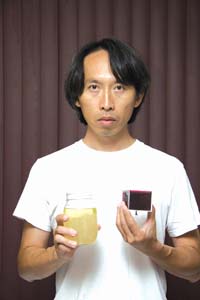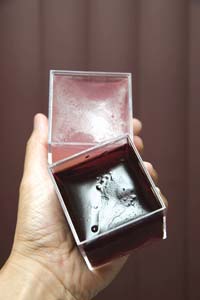


Chih-Chien Wang, Jelly Project #1 – A Collective Body, 2008. Multi-media installation, dimensions variable.
Stephen Lyons
SL: What brought you to Canada?
CW: I came here as an immigrant in 2000, arriving in Vancouver. I wanted to have the experience of moving to another country, and I thought that if I left Taiwan, I would want to stay in that country for a while. Canada could accept me as a resident and allow me to work for a long period of time, not just for one year. I didn’t have too many countries to choose from. There are not many countries that accept immigrants like Canada does.
SL: Before you came to Canada, you were filming documentaries for television in Taiwan. Why did you shift to making visual art?
CW: When I was working in television, the system was very powerful. In order to complete a work, we had to go through some very complicated processes that would distance the projects from our original intentions. I had been looking for something more pure than what I had done in documentary filmmaking. I thought I could find this in art. With art, I can get closer to presenting what is in my mind. My idea about art is a little bit naïve, and it can be very simple.
SL: Has your background in cinematography and documentary filmmaking influenced your current working process?
CW: I think so. I have more patience! I have worked on many photos and videos and I have always taken pleasure in simply using the camera to see the world. I find so many interesting things when I look through the camera, and I feel this is because of my background in documentary filmmaking.
SL: Who do you make art for?
CW: When I first started, I made art for a lover, for someone who really loves me, and whom I love too. However, recently I have been more interested in making art for myself, to respect my body and my thoughts. I just realized two days ago while I was walking that the body is like a plant which we have received as our life-long duty. Our duty is to grow this plant nicely, to keep the plant as healthy as possible. We need to respect the plant we have received.
SL: In order to create Jello Project # 1 – A Collective Body, you have spent the last few months entering the homes of people in your apartment building to sit and talk, while you use Jello to document these exchanges. Can you briefly discuss the framework underlying this project?
CW: There are a lot of Chinese people in my building. In this project, I am using the imaginary medium of Jello to recreate this Chinese connection. I am using Jello to record, to recreate.
SL: Do you explain the rationale behind your use of Jello to your participants? Is it important that those involved in the project know what is going on?
CW: We always work first, and then I explain. Usually, when I enter an apartment, I choose a spot for myself where the participants feel comfortable. We sit down. Then I start to make Jello and start taking notes, and we talk. We discuss the themes of Chinese connection and Norman Bethune, and we talk a little bit about the jelly. After the Jello has set, people are often very curious about the whole process. They have doubts in the medium itself. They wonder “what’s the point?” If I was making a documentary film, they would that they were facing the camera. They would express themselves to the camera. If I am using Jello to document our exchange, what could it mean to them? Should they really take the experience as seriously as I do?
SL: Can you discuss how the people in your building reacted to your project?
CW: Frankly speaking, this project has been very hard. I expected it would be difficult to invite myself into my neighbours’ homes. My Chinese neighbours are quite similar to me. Even though we look similar, even though we feel we should have closer contact with each other, most of us prefer to not have contact with the other Chinese people in our building. I had my poster downstairs by the mailboxes for two weeks, and no one contacted me. Then I started to hand out posters to the people in my building. Still no one contacted me. I think if there is anything I will find difficult to express in the exhibition, it is this: most Chinese people in my building would rather be isolated than have a closer connection to other Chinese people.
SL: I am curious about your intentions behind this project. Are you using the Jello as an excuse to get to know your neighbours? Or is this more of a conceptual art project intended to address the “idea” of using Jello as a form of documentation?
CW: It is really sad. I hesitated when I proposed this project to Alice [Ming Wai Jim], because I was a little bit tired of trying to get to know my neighbours. The whole project would force me to get to know them, to make me do what I should have done very long ago. However, like I was saying, everyone is a bit like me – we prefer to isolate ourselves.
SL: How did you come up with the idea of gelatin as a metaphor for human relations in time and space?
CW: Two years ago, I was discussing the classroom experience with a friend: the professor in dialogue with students, and the exchange of ideas and concepts within this space. I found that in the classroom, all different thoughts take physical space, and I thought that if for one moment I could have a big Jello that could really congeal the moment of knowledge transmission, it would be beautiful. I started to develop this image.
SL: Was the Jello project already in your head when the opportunity to participate in the Rearranging Desires exhibition arose or were you faced with an assignment?
CW: I already wanted to do a Jello project, but before Alice proposed this, I had planned to introduce the Jello project somewhere else. This is Jello Project #1, and there will still be Jello Project #2, and Jello Project #3.
SL: Your Jello absorbs the event, its architecture, the people, the ideas, the conversation. Would you call these little bricks of gelatin “portraits”?
CW: I think the objects themselves are just objects. But the process of creating the Jello can be similar to either portraits or landscapes, depending on the nature of the exchange. If we sit and talk, and spend lots of time looking at each other, and try to know what is in each other’s mind – like in this interview – this would be more like a portrait. If we spend more time looking at the space, then it is more like a landscape.
SL: How would you compare the act of capturing a duration in gelatin and doing so with photography or video?
CW: I think of photography or video as a product which is separate from the process of making that photo or video. Most of the time, we don’t have a camera with us. We just see, and we know what we’ve seen. We know we have taken a picture in our minds but one that we cannot print. The way Jello documents is very similar to the ways we document or record in our minds. We have no way to make these experiences a reality again.
SL: In your artist statement for this exhibition, you mention the idea of “architecture as a creature.” How is architecture a creature?
CW: If we begin with the belief that this Jello contains the connection between all the Chinese people in my building, then the Jello itself becomes a creature. It has blood inside it; we just don’t see it move.
SL: How are we, as visitors of Rearranging Desires, able to access the content and ideas that are archived within the gelatin?
CW: I am going to install the whole thing with very clear logic. It will be like a scientific exhibition. There will be a statement, followed by the notes, the objects, and the process of mixing the Jellos. The installation of the project will reveal traces of its imaginary nature. The whole thing is very fictional. It requires individual visitors to imagine the process. The notes, however, tell us something.
SL: How did you respond to the curatorial premise for this exhibition? In other words, how do you feel about this idea of creating a culturally-specific exhibition intended to critique the expectations that generally accompany the culturally-specific exhibition?
CW: I noticed that the issues were there, right after I arrived in Canada. There are always these situations where people have expectations about you based on physical appearances. I think the issue of expectations is important for us to be conscious of. People need to know how to see difference, or how to respect difference.
Sometimes I find that culturally-specific shows are very educational, but because in this show we already have our own art practices, I expect Rearranging Desires will have something more to offer than just education. I hope that this show is judged based on the quality of the work rather than if the purpose is good or bad.
SL: Is there anything else you would like to say?
CW: I would like to let people to know the name of the Jello that I am using; it’s called konjac.
September 19, 2008



Chih-Chien Wang, Jelly Project #1 – A Collective Body, 2008. Multi-media installation, dimensions variable.
Born in Taiwan, Chih-Chien Wang has been living in Montreal since 2002. He obtained a BFA in Theatre and Cinema from the Chinese Culture University in Taipei in 1994, and worked for several television companies producing documentaries before moving to Canada. Wang obtained an MFA in Studio Arts at Concordia University in 2005. Since then, his work has been mainly in photography and video. Wang’s work frequently contains subtle traces which might refer to personal, cultural or social concerns while dealing primarily with his everyday experience. He manipulates quotidian objects, including foods, and then creates still or moving images of them. His photographic works are often shown in series as a way to bring individual images into a larger context where the absurdity of contemporary life becomes obvious. Wang has received grants from the Canada Council for the Arts and le Conseil des arts et des lettres du Québec, and has participated in residency programs at Prim (Montreal, 2005) and El Basilisco (Buenos Aires, Argentina, 2007). Since 2004, Wang’s work has been seen in solo and group exhibitions held in Montreal, Lausanne, Milan, New York, Ping Yao, Peterborough and Toronto. Recent solo and group exhibitions include, in Montreal, Optica, Artefact, Dare-Dare (Mois de la photo à Montréal 2007), and the Leonard and Bina Ellen Gallery, Concordia University; Zenith Gallery (Beijing, 2008), Pierre-François Ouellette Art Contemporain (Montreal, 2008) and the Quebec Triennial 2008 at the Musée d’art contemporain de Montréal.
Stephen Lyons is a current MA student in Art History at Concordia University. His major research interests lie in the intersections between contemporary visual art and the cinema. He also maintains an art practice, specializing in photography and installation.